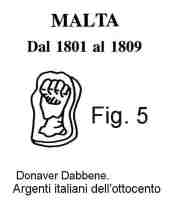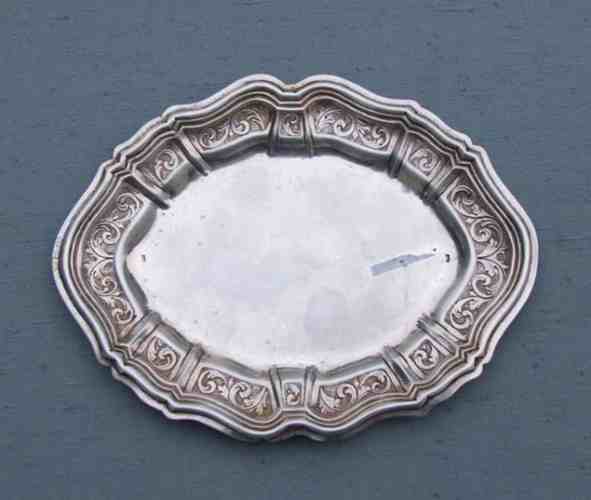by Andrea Menarini
(click on photos to enlarge image)
THE PLEASURE OF THE INVESTIGATION
I too am a fan of flea markets, antique shops or flea
markets, and on Sunday morning, as an employee going to work, I
leave for my hunt.
ASCAS members Katy Galewski and Lazar Freidgeim have well
illustrated the matter in their articles and the excitement
caused by the discovery of a rare piece buried in a basket of
junk.
It's an emotion that goes far beyond the gratification of having
done a bargain in economic terms. In her article Katy Galewski
confirms this feeling with the donation made after the purchase
of two Tiffany dishes bought for ninety cents in the Salvation
Army store
(see: Silver on My Mind).
It is the ancestral pride of the fisherman, of the hunter or of
the searcher for mushrooms who comes home with a nice booty, as
Lazar Freidgeim writes in his article
(see: Garage Sale Saga).
However, describing what happened to me in a flea market, I
would illustrate another aspect just as enjoyable as the
pleasure of the discovery, the taste of the bargain and the
pride of the chase. The pleasure of the investigation.
I see a small tray on a stand... I take the piece and watch it
carefully... it looks handmade and of excellent manufacture...
old enough... I would dare to say antique.
The tray bears on the bottom two marks "800" (a mark
identifying silver fineness on objects manufactured in Italy in
the 20th century). On its edge I note the presence of three
other marks, unknown to me but of ancient appearance.
The addition of new marks to antique pieces was a common
phenomenon in the early 1900's in Italy. This happened when a
piece, unmarked or bearing unknown marks, was submitted to a
silversmith to verify the quality of the metal. Often the
silversmith confirmed his expertise marking the object with
"800" (an unofficial but largely used mark until 1935 c.).
Now can start the negotiation; an essential ritual on flea
markets. After a proper bargaining we reach an agreement on a
figure satisfying both parts.
If the tray was manufactured in the early twentieth century, as
suggested by the "800", the price is reasonable.
All the better for me if the piece is of earlier manufacture, as
suggested by the unknown marks.
Now I have the piece and the investigation can start.
Back to home I carefully examine the marks: a Maltese cross, an
"M" and another rubbed mark virtually unreadable.
The Maltese cross is a symbol frequently used in silver
hallmarking. This makes difficult the identification of its
origin, but the shape of the octagonal incuse narrows the range
of possible alternatives.
Consulting my books I find only four marks having some
similarity to the Maltese cross on the tray.
I think unlikely that the mark belongs to Simone Palmieri
(fig. 1). This silversmith died in 1716, and the tray doesn't
look as an artifact three centuries old.
The mark of Spoleto (Papal States, mid-18th century) is
compatible (fig. 2).
Also the mark in Fig. 3 Paderborn (Germany 18th century
according to Jan Divis and 19th century according to Tardy) is
compatible.
The mark of Malta after 1982 (Fig.4) is a not plausible
hypothesis as the tray looks of older manufacture.
I follow the same path with the "M". I find many "M" in my books,
more or less similar to mine, but none attributable to Spoleto
or Paderborn. Many "M" refers to Malta.
The last mark seems indecipherable: a man's head? a closed hand?
an animal's head? who knows ......
I am forced to admit that the survey based on my books did not
lead to an acceptable solution.
I get the same disappointing result posting the question in a
Silver Forum.
My further chance is Pietro Fantazzini, an expert silversmith in
his shop in Bologna. I frequently apply to his experience for
information and advice about a silver object. In these cases he
"visits" the piece, just as does a doctor with his patient,
carefully handling it and looking from a distance and close.
Then he uses the lens rubbing the piece with his fingers,
measures its size, sometimes breathes above to see something I
do not know (maybe he sniffs too) and finally issues his
opinion, usually in terms as "there are no obvious signs that
place this artifact surely after a certain date".
After his "visit" of the tray Piero is of the opinion that it
can be ancient.
This may seem a vague response, but actually has its own logic.
An expert craftsman could even today manufacture a piece
starting from a silver ingot with techniques used 150 or 200
years ago. Obviously in the west this is no longer profitable
business, but some time ago I saw a Vientiane workshop with a
dozen of artisans making as in the past, by hand and without the
aid of any mold, exquisite silver bowls decorated with intricate
floral motifs. Artisans as those would be able to make a tray
like the one we are dealing with.
|
Pietro Fantazzini believes that the "800" marks
are a later addition, but he also agrees that, until
now, we have no concrete evidence about origin and
date of the tray. However, leafing through the pages
of our books, he comments that the indecipherable
mark could be a "closed hand" like that used in
Malta at the beginning of the nineteenth century
(Fig. 5).
The incuse looks different, but the suggestion
triggers a mental mechanism: the cross of Malta... M
of Malta... possibly the "closed hand" of Malta...
An in-depth research on Malta hallmarks is required!
|

|
Searching on the internet I find the book "The Silver of
Malta" which is available in a public library in my town.
The book is the illustrated catalog of the exhibition of Maltese
silver held in Valletta in 1985. In an appendix are illustrated
the maker's marks and some other marks used in Malta in various
periods. In the last page of the book finally I find the mark of
Saverio Cannataci (Fig. 6).
The shape and the period (19th century) can be compatible
with my tray and the temporal incongruity (late 20th century) of
the mark in Fig.4 is now resolved. In the book there is also a
Holy Water Stoup (page 168) with marks (not illustrated)
described as:
- Maltese standard
- Upheld hand mark
- Maltese cross in octagonal punch, for Saverio Cannataci
(1806).
I'm on the right track! To solve the last doubts I contact the
author of the book Alaine Apap Bologna. After few hours, with
exquisite courtesy, she answers to my mail:
"...You have a pretty Maltese piece there. I have a feeling that
this is a platter which accompanied a set of altar cruets. I see,
from bottom:
- Alexander Ball's "fist" assay mark: 1800-1810
- "M" for Maltese standard mint mark, of the same period ( I.e.
835/1000 alloy, ca.)
- Maltese Cross in octagonal punch, for Saverio Cannataci. He
was registered as silversmith in 1806. His maker's mark is SA/CA
in plain shield.
Now here is a problem I haven't as yet solved: He became Consul
for silversmiths in 1848. This punch should be his Consul's mark,
so something doesn't tally. This isn't the first time I have
encountered this set of marks... I hope to find out, sometime
soon, about this..."
After the author's confirm, the puzzle is solved and all its
pieces seem to be in the right place. Some uncertainty remains
about the mark of Saverio Cannataci, but this is a not uncommon
situation.
Finally I have completed my investigation finding the origin of
the tray and the period of its manufacture; a result not often
achieved.
Anyway, also in case of failure, remains the pleasure of the
research and the cultural enrichment obtained from reading books
and consulting experts in the matter.
Solved or not a "mystery", the research is always a great and
enjoyable adventure.
|
|





